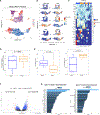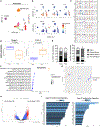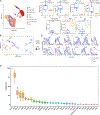Immune determinants of CAR-T cell expansion in solid tumor patients receiving GD2 CAR-T cell therapy
- PMID: 38134936
- PMCID: PMC10947809
- DOI: 10.1016/j.ccell.2023.11.011
Immune determinants of CAR-T cell expansion in solid tumor patients receiving GD2 CAR-T cell therapy
Abstract
Chimeric antigen receptor T cells (CAR-Ts) have remarkable efficacy in liquid tumors, but limited responses in solid tumors. We conducted a Phase I trial (NCT02107963) of GD2 CAR-Ts (GD2-CAR.OX40.28.z.iC9), demonstrating feasibility and safety of administration in children and young adults with osteosarcoma and neuroblastoma. Since CAR-T efficacy requires adequate CAR-T expansion, patients were grouped into good or poor expanders across dose levels. Patient samples were evaluated by multi-dimensional proteomic, transcriptomic, and epigenetic analyses. T cell assessments identified naive T cells in pre-treatment apheresis associated with good expansion, and exhausted T cells in CAR-T products with poor expansion. Myeloid cell assessment identified CXCR3+ monocytes in pre-treatment apheresis associated with good expansion. Longitudinal analysis of post-treatment samples identified increased CXCR3- classical monocytes in all groups as CAR-T numbers waned. Together, our data uncover mediators of CAR-T biology and correlates of expansion that could be utilized to advance immunotherapies for solid tumor patients.
Keywords: CAR-T cells; cancer; chimeric antigen receptor; correlative studies; immune suppression; immunotherapy; monocytes; myeloid cells; osteosarcoma; pediatric oncology; solid tumor.
Published by Elsevier Inc.
Conflict of interest statement
Declaration of interests C.J.W. receives research funding from Pharmacyclics and hold equity in BioNTech, Inc. F.M. is a cofounder of and has equity in Harbinger Health, has equity in Zephyr AI, and serves as a consultant for Harbinger Health, Zephyr AI, and Red Cell Partners and Exscientia. F.M. declares that none of these relationships are directly or indirectly related to the content of this manuscript. E.S. consults for and holds equity in Lyell Immunopharma and consults for Lepton Pharmaceuticals and Galaria. M.S.M. is currently employed at Normunity and holds stock in AstraZeneca; her contributions to this work were made prior to these industry positions which are not relevant to the content of this manuscript. C.L.M. is an inventor on numerous patents and patents pending related to CAR-T cell therapies. C.L.M. holds equity in and receives research funding from Lyell Immunopharma and holds equity in and consults for CARGO Therapeutics and Link Cell Therapies. C.L.M. consults for Immatics, Mammoth, Ensoma, and Red Tree Venture Capital.
Figures






Comment in
-
GD2-CAR CAR T cells in patients with osteosarcoma and neuroblastoma-it's not only the T cells that matter.Cancer Cell. 2024 Jan 8;42(1):8-10. doi: 10.1016/j.ccell.2023.11.012. Epub 2023 Dec 21. Cancer Cell. 2024. PMID: 38134937
References
-
- Louis DN, Perry A, Reifenberger G, von Deimling A, Figarella-Branger D, Cavenee WK, Ohgaki H, Wiestler OD, Kleihues P, and Ellison DW (2016). The 2016 World Health Organization Classification of Tumors of the Central Nervous System: a summary. Acta Neuropathol. 131, 803–820. - PubMed
-
- Ceschel S, Casotto V, Valsecchi MG, Tamaro P, Jankovic M, Hanau G, Fossati F, Pillon M, Rondelli R, Sandri A, et al. (2006). Survival after relapse in children with solid tumors: a follow-up study from the Italian off-therapy registry. Pediatr. Blood Cancer 47, 560–566. - PubMed
-
- Meyers PA, Schwartz CL, Krailo MD, Healey JH, Bernstein ML, Betcher D, Ferguson WS, Gebhardt MC, Goorin AM, Harris M, et al. (2008). Osteosarcoma: the addition of muramyl tripeptide to chemotherapy improves overall survival–a report from the Children’s Oncology Group. J. Clin. Oncol. 26, 633–638. - PubMed
Publication types
MeSH terms
Substances
Associated data
Grants and funding
- T32 GM007365/GM/NIGMS NIH HHS/United States
- T32 AI007290/AI/NIAID NIH HHS/United States
- F30 CA271797/CA/NCI NIH HHS/United States
- U24 CA224316/CA/NCI NIH HHS/United States
- K08 CA267057/CA/NCI NIH HHS/United States
- U24 CA224331/CA/NCI NIH HHS/United States
- R01 CA202987/CA/NCI NIH HHS/United States
- ZIA BC011332/ImNIH/Intramural NIH HHS/United States
- P30 CA124435/CA/NCI NIH HHS/United States
- U24 CA224309/CA/NCI NIH HHS/United States
- ZIA BC011334/ImNIH/Intramural NIH HHS/United States
- U01 CA224766/CA/NCI NIH HHS/United States
LinkOut - more resources
Full Text Sources
Medical

